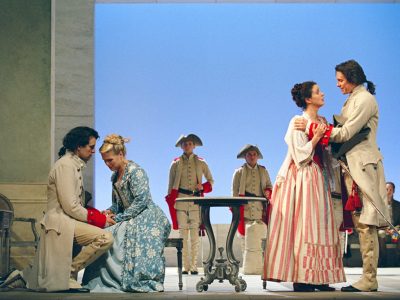
Musical highlights
Explore the musical moments to look out for in Cosí fan tutte
Fiordiligi’s Aria ‘Come Scoglio’
In an opera full of stand-out arias, Fiordiligi’s ‘Come Scoglio’ is the highlight. It’s written as a showpiece for a dramatic coloratura soprano – a particularly agile, high type of soprano, capable of extremes of emotion and technical skill.
Fiordiligi sings that she is ‘like a rock’ – unmoved by temptation. But the music tells a different story. Spanning more than two octaves, from the very bottom to the top of the soprano’s range, and featuring lots of unusually large and striking musical leaps, it reflects the opposing forces that pull the character in two different directions.
Fiordiligi’s racing thoughts are expressed in the semiquaver ornamentation that runs throughout the aria, that just cannot seem to settle anywhere. Her words tell us that she is a rock – strong against the raging seas – but the music paints her instead as a ship, battered in every direction by the waves of fate.
While Fiordiligi’s emotions are absolutely sincere, Mozart’s music never quite loses touch with the opera’s comic spirit. The style is deliberately exaggerated, almost a parody of what an opera aria should be, as though the composer is poking fun at a character (and a genre) that takes itself just a bit too seriously.
Trio – ‘Soave sia il vento’
This trio for Don Alfonso, Fiordiligi and Dorabella is probably the opera’s best-known passage. Why? Because it’s a rare moment where humour, parody and excess all fall away, leaving behind the simplest musical beauty.But, as ever with Mozart, what sounds simple is in fact the result of tremendous musical sophistication.
Sung as Ferrando and Guglielmo depart ‘to war’, the trio is an extended musical farewell. The two men set off in a boat, and you can hear the gentle waves of the sea that carries them away in the lapping semiquaver accompaniment that underpins the whole trio.
The sincerity of the sisters’ shared feelings is expressed in arching homophonic vocal lines, which move in parallel throughout. There’s nothing affected or performative here, just an organic outpouring of emotion.
While the sisters share one musical thought, Don Alfonso’s vocal line takes a path all its own. Listen to how he pushes to the foreground in a cadenza-like moment towards the end of the trio. Ever the showman, he cannot resist the opportunity for a little dramatic display.
A minor key would be the obvious choice for a sad musical farewell, but Mozart defies expectations to great effect. The key signature of sunny E major gives the music a particular pathos. The effect is of smiling through tears.











